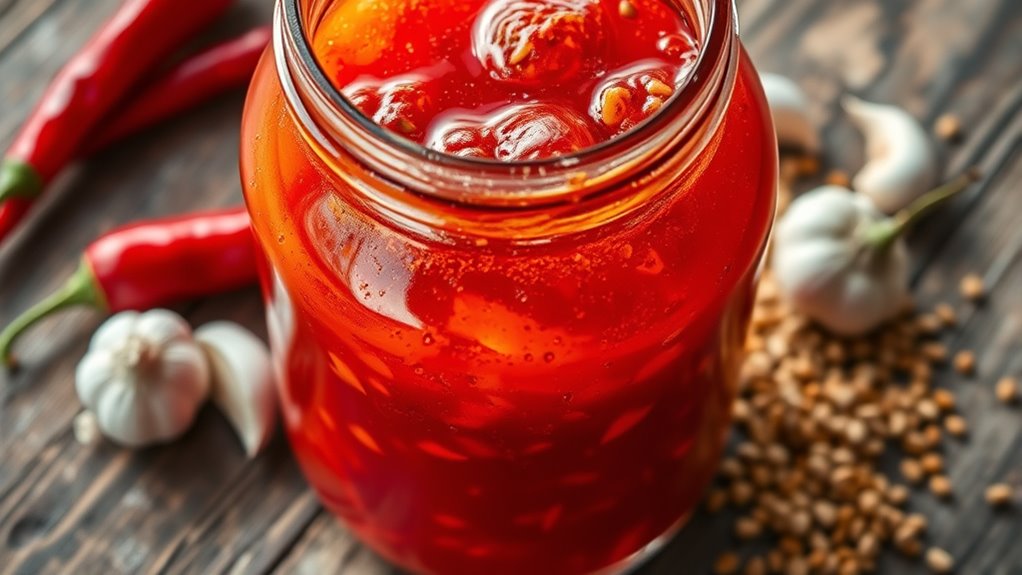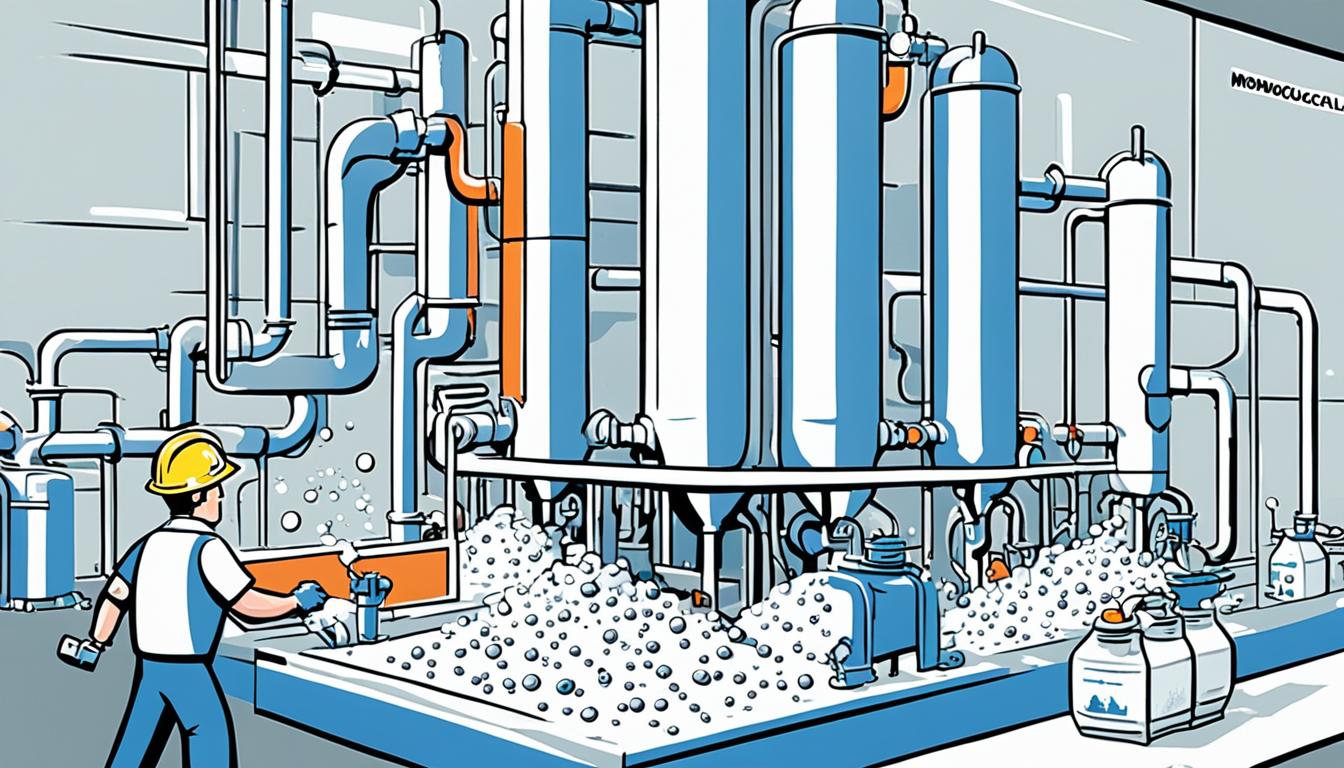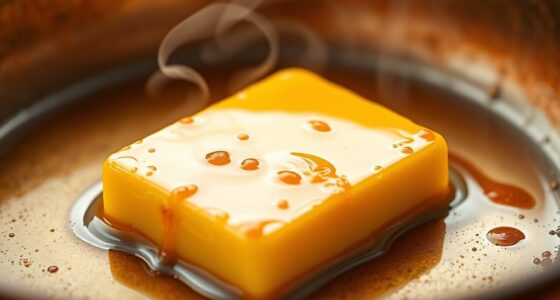To make fermented hot sauce safely, you need to understand the beneficial bacteria that give it that fiery punch. These good bacteria, mainly lactic acid bacteria, thrive in an environment with fresh ingredients, proper salt levels, and good hygiene. They outcompete harmful microbes, ensuring your sauce develops flavor and stays safe. Consistently monitoring the process helps keep these beneficial bacteria dominant—stay tuned to discover how to create a perfect, safe ferment every time.
Key Takeaways
- Beneficial bacteria like lactic acid bacteria dominate in fermented hot sauce, creating its signature tang and safety.
- Proper salt levels and clean ingredients foster an environment where good bacteria thrive while inhibiting harmful microbes.
- Maintaining hygiene and monitoring fermentation helps ensure beneficial bacteria remain dominant, preventing spoilage.
- The bacteria convert sugars into lactic acid, preserving the peppers and developing complex flavors.
- Understanding the role of bacteria ensures a safe, flavorful hot sauce with probiotic benefits for health.

Fermented hot sauce offers a bold, tangy kick that enhances any dish with complex flavors. But before you dive in to making your own, it’s essential to understand the importance of fermentation safety and ingredient selection. Ensuring your fermentation process is safe isn’t just about avoiding spoiled or unsafe products; it’s about creating a healthy environment for beneficial bacteria to thrive. When you start, you want to use clean utensils and containers, and keep everything sanitized to prevent unwanted bacteria or mold from taking hold. Proper hygiene reduces the risk of contamination, which can spoil your hot sauce or pose health risks. Paying close attention to fermentation safety means monitoring your process and being attentive to any signs of spoilage, such as foul odors, mold, or discoloration, and discarding the batch if anything seems off.
Ingredient selection is equally critical. The quality of your ingredients directly impacts the flavor and safety of your fermented hot sauce. Use fresh, high-quality peppers, garlic, salt, and other flavorings. Fresh peppers will provide the right amount of heat and vibrant flavor, while older or spoiled peppers may introduce undesirable bacteria or molds. When selecting ingredients, opt for organic or pesticide-free options if possible, as these tend to be cleaner and safer for fermentation. Salt plays an indispensable role in creating an environment that favors good bacteria and inhibits harmful microorganisms. A proper salt-to-vegetable ratio is key—you typically want to use non-iodized salt, like sea salt or pickling salt, since iodine and other additives can interfere with fermentation. Additionally, understanding how different glycolic acid concentrations can influence skin health can be useful if you are considering skin-safe ingredients or topical applications alongside your fermenting process.
You should also consider the moisture content of your ingredients. Too much water can dilute the salt concentration, allowing undesirable bacteria to flourish, while too little can hinder fermentation. The peppers and other ingredients should be fresh and firm, with no signs of decay. When chopping or preparing your ingredients, do so with clean knives and cutting surfaces. Remember, the goal is to create an environment where beneficial bacteria, such as lactic acid bacteria, can dominate. This not only guarantees fermentation safety but also results in a flavorful, probiotic-rich hot sauce. By paying attention to ingredient selection and maintaining strict hygiene, you set the foundation for a successful fermentation that’s both safe and delicious. With these fundamentals in mind, you’ll be on your way to crafting a fiery hot sauce packed with complex, tangy flavors that elevate your dishes.
Frequently Asked Questions
How Long Does Homemade Fermented Hot Sauce Typically Last?
You’re probably wondering how long homemade fermented hot sauce lasts. Generally, with proper fermentation storage, your hot sauce can stay good for up to six months to a year in the fridge. The hot sauce shelf life depends on factors like cleanliness and ingredients. Keep it refrigerated, and always check for signs of spoilage before using. Proper storage helps maintain flavor and ensures safety over time.
Can I Use Any Type of Chili Peppers for Fermentation?
Imagine your chili peppers are actors auditioning for a play—each chili variety brings a unique flavor to the stage. You can use many chili pepper varieties for fermentation, but not all are equally compatible. Some, like jalapeños and habaneros, work well and add distinct heat, while others might not ferment as reliably. To guarantee a successful performance, choose peppers known for fermentation compatibility to craft your fiery masterpiece.
Is It Safe to Consume Unpasteurized Fermented Hot Sauce?
You might wonder if unpasteurized fermented hot sauce is safe to eat. Raw fermentation relies on beneficial microbes to develop flavors, but it also carries risks if hygiene isn’t maintained. To guarantee microbial safety, keep everything sterile and monitor the fermentation process closely. If it looks, smells, and tastes right, it’s generally safe, but always trust your senses. When in doubt, pasteurizing can add extra safety by killing unwanted bacteria.
What Are Common Signs of Spoilage in Fermented Hot Sauce?
Think of your fermented hot sauce as a fiery treasure chest, but beware of dark clouds forming inside. If you see mold growth or notice an off odor, those are your warning signs of spoilage. These clues indicate unwanted bacteria or mold taking over. Trust your senses—if it smells or looks wrong, it’s time to toss it out before it ruins your fiery adventure. Safety comes first in spicy escapades!
How Can I Adjust the Spiciness Level of My Fermented Hot Sauce?
To adjust the spice level of your fermented hot sauce, you should modify the peppers you use. For more heat, add extra spicy peppers or ferment for a shorter time to preserve their heat. If you want milder sauce, reduce the amount of spicy peppers or extend fermentation time to mellow the heat. Remember, fermentation time affects flavor, so experiment until you find your perfect spice balance.
Conclusion
Now that you know the magic behind fermentation, you’re ready to craft your own fiery hot sauce. Remember, each batch is a unique adventure, brimming with beneficial bacteria that transform simple peppers into a tangy, spicy masterpiece. Don’t let fear of the unknown hold you back—embrace it. After all, isn’t life more flavorful when you dare to experiment? So go ahead, ferment your passion into a hot sauce that’s truly your own.










